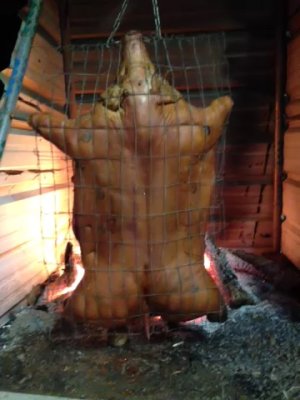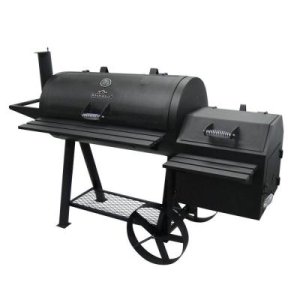PuJo
Found some matches.
Hello Gang.
I have no experience smoking meat, but do cook whole hog 3 times a year. So not exactly new to BBQing.
My wife gave me a gift of a new "Offset Smoker" and I don't have a clue how to use it properly for smoking. It's a FarmersGrille if that tells you anything.
She purchased it from Home Depot.
From watching a few YouTube video's, I can already see that I need to make a few mods.
First, I would like to stop the smoke from leaking out from the cooking door. I saw someone was using some kind of gasket material for BBQ pits. I haven't found this on the net. Please post link if you know where I can find some.
Second, I saw a piece of sheet metal with holes in it to even out the heat.
Is this necessary? Is there a good benefit to using this?
Third, should I plum the exhaust down to the grating?
I tried cooking on it once, and it didn't come out too good.
I had a hard time keeping the temp where I wanted it, I used so much wood, I can smell the creosote in the pit now, and the meat was too smokey. I also tried the YouTube thing for managing the fire, but that didn't work out either. I used 20 pieces of charcoal just to get the wood burning, then used all pecan wood after that. Cooked for about 6 hrs. Should I have used charcoal instead of split wood? I have wood coming out of my ears here and it is all extra dry wood. Should I use green wood?
I know its a lot of questions, and I have more!
Hope you guys can help me out.
Thanks,
Pujo
I have no experience smoking meat, but do cook whole hog 3 times a year. So not exactly new to BBQing.
My wife gave me a gift of a new "Offset Smoker" and I don't have a clue how to use it properly for smoking. It's a FarmersGrille if that tells you anything.
She purchased it from Home Depot.
From watching a few YouTube video's, I can already see that I need to make a few mods.
First, I would like to stop the smoke from leaking out from the cooking door. I saw someone was using some kind of gasket material for BBQ pits. I haven't found this on the net. Please post link if you know where I can find some.
Second, I saw a piece of sheet metal with holes in it to even out the heat.
Is this necessary? Is there a good benefit to using this?
Third, should I plum the exhaust down to the grating?
I tried cooking on it once, and it didn't come out too good.
I had a hard time keeping the temp where I wanted it, I used so much wood, I can smell the creosote in the pit now, and the meat was too smokey. I also tried the YouTube thing for managing the fire, but that didn't work out either. I used 20 pieces of charcoal just to get the wood burning, then used all pecan wood after that. Cooked for about 6 hrs. Should I have used charcoal instead of split wood? I have wood coming out of my ears here and it is all extra dry wood. Should I use green wood?
I know its a lot of questions, and I have more!
Hope you guys can help me out.
Thanks,
Pujo




